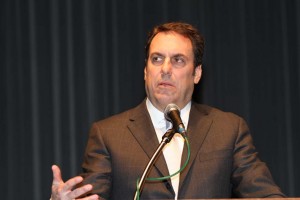
General Motors must succeed on its products, not its competitors' misfortunes, says GM President Mark Reuss.
There might be a rare opportunity to take advantage of its arch-rivals problems, but Mark Reuss, General Motors’ new president of North American operations , insists he’d rather do it the old fashioned way, with better product.
Nonetheless, seven months after emerging from bankruptcy, the “new” GM is in a much better position than it has been in decades, Reuss said repeatedly, during a series of conversations this week, as well as his keynote speech at the 2010 Chicago Auto Show.
The executive pointed to GM’s “May the Best Car Win” program as a sign that customers see big improvements in the company’s cars, trucks and crossovers. The recently-concluded marketing campaign offered potential customers the opportunity to buy a GM vehicle – and then return it if it didn’t meet their expectations. Of 439,000 eligible buyers, only 505 returned their vehicles, Reuss revealed, adding that in some cases, buyers simply choose to swap for a different General Motors vehicle.
While the GM President echoed a line some of his predecessors have used, citing a potential “well of pent-up demand” for American-made vehicles, Reuss made it clear he is taking a different tact from the past. He repeatedly declined to blame any of GM’s woes, past or present on the lack of a “level playing field.” Former General Motors CEO Rick Wagoner routinely pointed to such things as lopsided exchange rates as key factors in the company’s failure to win back share from its Japanese rivals, for example.
“I do not worry about what was said in the past,” insisted Reuss.
Since emerging from bankruptcy, the humbled giant has been struggling to rebuild using just four brands – having been forced to abandon the Pontiac and Saturn marques, while selling off Hummer and Saab, as part of its court-ordered reorganization. The heavy lifting is now up to the Chevrolet division, which has been responsible for nearly two-thirds of GM’s North American sales, in recent months.
A number of the brand’s new models have been winning solid, third-party endorsements from influential forces like J.D. Power and Associates and Consumer Reports magazine, and Reuss said, “I’d rather get people to try our cars based on (such) endorsements, and their attributes,” rather than by slamming competitors having their own troubles.
But some question that, noting that the automaker recently launched sales incentives specifically targeting Toyota, which is in the midst of a scandal over quality and safety-related problems. Meanwhile, the latest Chevy ads have been targeting Toyota products by touting the domestic maker’s advantages in terms of price, fuel economy – and sensitive issues like quality.
“Shoot me if I ever do that,” complained Toyota Group Vice President Bob Carter, who insisted he had “plenty of opportunity to do that” when GM – and Chrysler – were in bankruptcy court, last year.
GM has relied heavily on incentives, over the years, to offset its weak product reputation. Company officials, including new marketing director Susan Docherty, have promised to trim back on such costly givebacks, which have run as high as $5,000 for the typical General Motors product, in recent years. For his part, Reuss said the company is rethinking the fundamental way it relies on such tools as rebates. Going forward, they’ll be used as a more strategic, spot tool, often to offset the ups-and-downs in the pricing of key competitors.
While things have begun to stabilize for the automaker, Reuss has plenty of obstacles to deal with. That includes the arbitration program ordered by Congress as a response to the automaker’s decision to fire about 2,000 dealers using the bankruptcy process. More than half those retailers have filed for a hearing, and though many are expected to back down before the complicated process is completed, GM’s new CEO Ed Whitacre Jr. has suggested the company may have to reinstate “hundreds.”
The bankruptcy process, and those firings, in particular, have created plenty of bad blood that GM is now coping with. For his part, Reuss said, “my number one priority, this year, is rebuilding our relations with dealers.” He has been calling many and meeting with more. And he intends to do plenty of fence-mending this coming meeting when he attends the annual convention of the National Automobile Dealers Association, in Orlando.
Reuss is, in fact, taking the phrase, “hands-on,” quite seriously. He has implemented several programs designed to help owners with product problems and occasionally makes calls to those drivers himself. He has also called a number of the buyers who decided to return cars under the “May the Best Car Win” program to find out why they weren’t satisfied.
Getting a call from the GM president, he has found, is something troubled customers don’t expect, and often comes “to the customer’s delight,” he said, adding that, “They didn’t think we were listening.”

Mr. Reuss is a most welcome change atop General Motors. by all appearances, this guy “gets it”. The task in front of him is huge, stabilizing dealer relations, altering customer perceptions, streamlining incentives, and cautiously increasing production. His willingness to break from the past, take a clean sheet approach, and truly listen are all positive signs that should lead to recovery at GM.